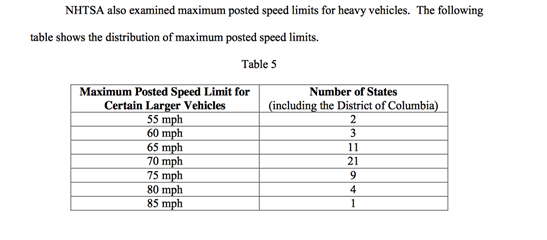
States set posted speed limits for what they feel is safe on their roads and highways and I am questioning why FMCSA should get involved. The state sets these limits and it is up to the state to enforce their speed limit. For example if Texas does not think that the top speed for trucks should be 85 MPH then the state needs to change the signs. Enforce the speed limits we have on cars and trucks alike. Why over ride what states have determined is their safe speed?
Many trucks are speed limited now due to their companies policies or those trucks that come and go out of two of Canada's eastern provinces. Some dealers when spec'ing trucks have the speed limited when the truck is ordered. These speed-limited trucks have a variety of top speeds they can run.
Company trucks are often limited on their high speed and each company can set the speed limiter to what they deem is safe for their company and drivers. Even with all of these limited trucks many more are not limited and can pass with ease and move over for the faster vehicles to get by. Road rage will become an issue if most drivers flat foot the throttle or bump the speed limiter and cause blockages when passing.
Freightliner has the Assurance system and other OEM's have systems that use collision mitigation and this system will lesson the impact in case of an incident. The OEM's have addressed the issue of slowing down a commercial vehicle before an impact and the need for speed limiters again makes zero sense.
The savings and safety cited in 49 CFR Part 571 in my opinion are flawed as the assumption has been made that all commercial vehicles run the posted speed limit when most trucks do not.
One of the proposals makes perfect sense if used on all vehicles not just trucks:
NHTSA also requests comment on the feasibility of technologies which would limit the speed of the vehicle to the speed limit of the road, as an alternative option to the a requirement limiting vehicle speed to a specified set speed. These technologies might include a GPS, vision system, vehicle to infrastructure communication, or some other autonomous vehicle technology.
This thought really scared me that is buried down towards the bottom of this document, it scares me that it was even thought of. We all ready have a problem with vehicles merging on to interstates to slow and causing problems.
Given the extreme precision that would be required both of the speed control device and the test equipment, NHTSA proposes not to include the acceleration limits as specified in the UNECE standard. We seek comment as to the necessity of an acceleration limit and, if needed, what a reasonable limit could be.
So in conclusion the proposed speed limit rule making it unnecessary as the OEM's have addressed the issue with the collision mitigations systems. Instead of spending the money to equip weight stations and officers with the ability to plug into ECM's spend the money on enforcing all ready in place speed limits.
To read the complete document:
To Comment and everyone needs to comment: